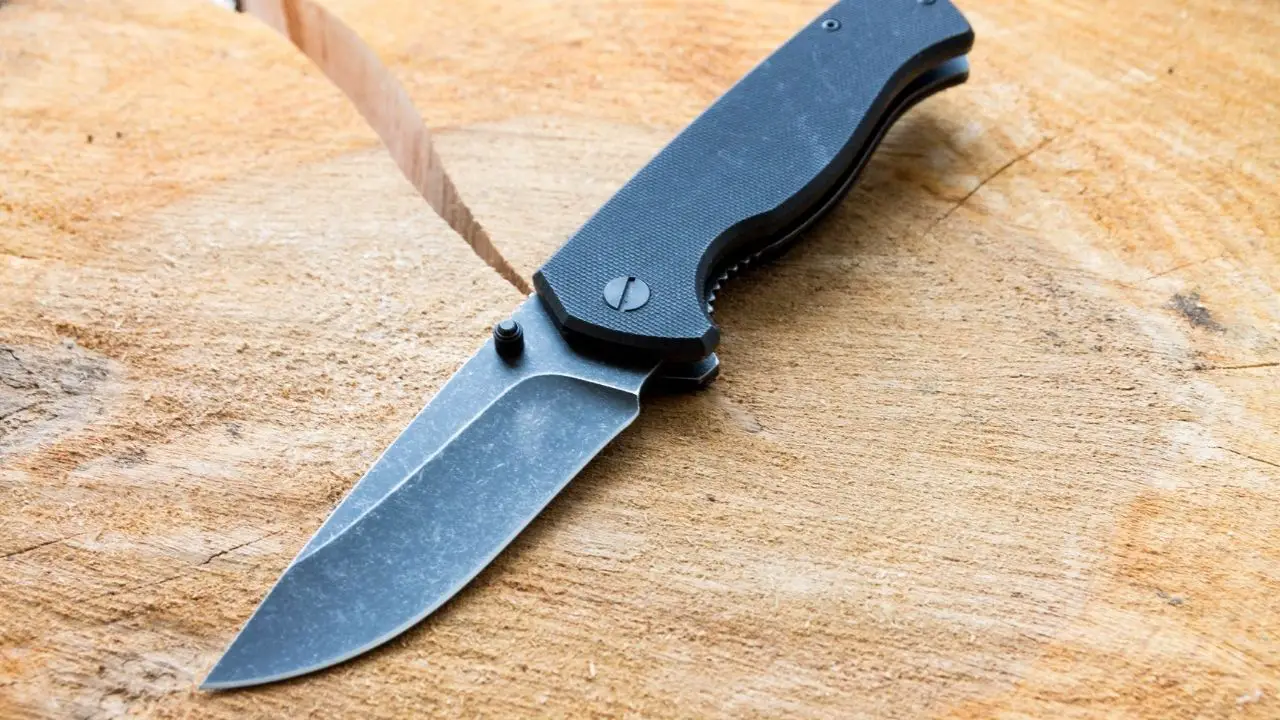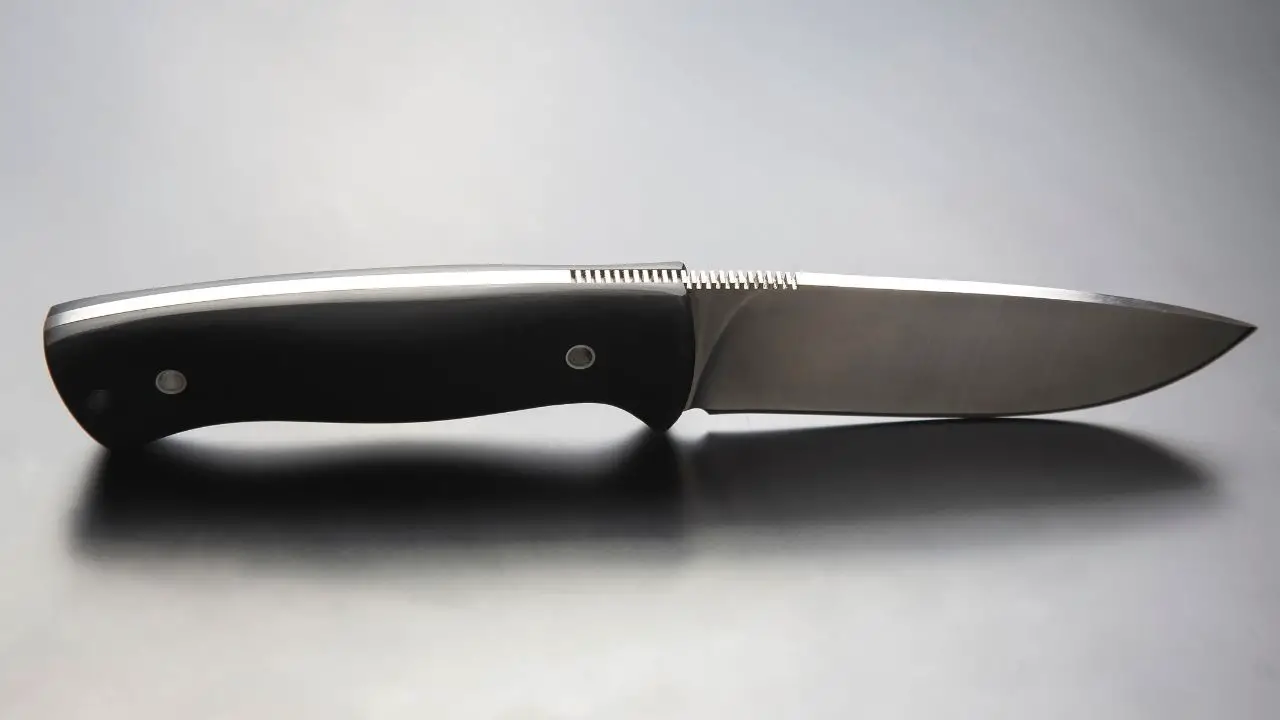When making or getting a new knife, you want to choose the best handle material for your needs. G-10 and Micarta are two extremely popular handle materials, but which one is the best, and which should you choose?
G-10 and Micarta are both resin-based composites that make excellent knife handles. Micarta is made from resin and burlap, while G-10 is primarily fiberglass. Both materials are durable, water-resistant, and comfortable to use, but G-10 costs less and is less susceptible to environmental factors.
Both G-10 and Micarta are excellent knife handle materials, but they each have their own unique set of characteristics and qualities. In this article, I’ll compare many different aspects of each material to help you decide which one is best for you.
Table of Contents
G-10 Vs. Micarta Knife Handles

Depending on your likes, dislikes, and needs, G-10 may be a much better option than Micarta or vise versa. They are both reputable and well-liked handle materials, and they each have their place in the world of knives. So let’s get on with the comparison!
Composition
G-10 and Micarta are composite materials, which simply means that they consist of more than one dissimilar material merged together (in the case of Micarta and G-10, resin and another fabric material).
The manufacturing process for G-10 and Micarta is extremely similar, but the differences between the two materials become apparent when looking at their composition. Micarta is much more natural, while G-10 consists of many synthetic materials.
G-10 Composition
G-10 is a composite material created from fiberglass and a synthetic epoxy resin. It all begins by soaking fiberglass cloth in epoxy and then layering the soaked fabric. Once everything is ready, you use extreme heat and pressure to compress the epoxy and fiberglass to form the composite material we all know as G-10.
Micarta Composition
Micarta is the popular brand name for resin and fabric composite materials, consisting of two main types: canvas and linen (there are also Micarta variations made from burlap, paper, fiberglass, carbon fiber, and more). Much like the G-10 manufacturing process, you make Micarta by soaking linen or canvas in organic phenolic resin and then compressing it all together using high pressure and heat.
Price
While price doesn’t often directly reflect quality, many people like to factor it into their decision when choosing a knife handle material. Many factors go into the price of both Micarta and G-10.
While the most obvious factor is the cost of the material itself, shaping the material into a knife handle and adding any need texture can also add to the price. Both materials are pretty slick when raw, but Micarta typically requires a little more labor and texturing to make into a good knife handle than G-10.
Looking at both materials on Alpha Knife Supply , here is a quick price comparison of G-10 and Micarta:
, here is a quick price comparison of G-10 and Micarta:
| Material | Material Color | Material Size (Inches) | Price | Price Per Square Inch |
| G-10 | Black | .120 x 11.6 x 8.5 | $15.60 | $0.16 |
| Canvas Micarta | Black | .125 x 11.6 x 8.5 | $11.70 | $0.12 |
| Linen Micarta | Black | .125 x 11.6 x 8.5 | $13.60 | $0.14 |
| Burlap Micarta | Black | .125 x 11.6 x 8.5 | $25.30 | $0.26 |
| Paper Micarta | Black | .125 x 11.6 x 8.5 | $11.20 | $0.11 |
Prices vary depending on many factors, but hopefully, the above data gives you some insight or a reference point for the cost of G-10 and the different types of Micarta. According to this analysis, canvas Micarta is 25% cheaper than G-10.
Just because this data shows that G-10 is generally more expensive than Micarta doesn’t mean that’s always the case. For instance, the ESEE-3 has a version with a G-10 handle and a Micarta version
and a Micarta version , and the Micarta one is slightly more expensive.
, and the Micarta one is slightly more expensive.
Durability
Compared to other common knife handle materials, G-10 and Micarta are some of the most durable and robust options. For most people who use their knives as EDC tools or for outdoor use, both Micarta and G-10 will hold up just fine.
According to Accurate Plastics , below are the tensile and compressive strength numbers for both G-10 and Micarta. For those unfamiliar or who just need a refresher, tensile strength is a material’s strength when pullout outwards, and compressive strength is when it’s compressed inwards.
, below are the tensile and compressive strength numbers for both G-10 and Micarta. For those unfamiliar or who just need a refresher, tensile strength is a material’s strength when pullout outwards, and compressive strength is when it’s compressed inwards.
| Material | Lengthwise Tensile Strength (PSI) | Crosswise Tensile Strength (PSI) | Flatwise Compressive Strength (PSI) | Edgewise Compressive Strength (PSI) |
| G-10 | 40,000 | 35,000 | 60,000 | 35,000 |
| Canvas Micarta | 9,000 | 7,000 | 39,000 | 24,500 |
| Linen Micarta | 12,500 | 8,750 | 37,000 | 25,000 |
While the data shows that G-10 is stronger than Micarta in every category, you should not wholly write Micarta off as a knife handle material. For most situations and people, both materials offer more than enough durability.
G-10 has a Rockwell Hardness rating of 110, while Micarta has a 100 RC.
The fiberglass cloth material used in G-10 creates a weaving pattern that gives it incredible strength and durability. The more natural and softer linen and canvas used to create Micarta simply doesn’t have the same level of strength.
Both materials are extremely strong, hard to scratch, and super durable, but G-10 is usually the favored one if durability and strength are primary factors in your decision.
Water Resistance
Micarta is more natural, and its linen, canvas, burlap, or paper ingredients are susceptible to moisture absorption. Sometimes the phenolic resin in Micarta has microscopic cracks and holes, which allows a small amount of water to seep into the outer layers of the material.
Dents, scratches, and regular wear and tear can increase water absorption, but barring a large crack or gouge in the Micarta, it isn’t much of a concern.
G-10, made from epoxy resin and fiberglass, has fewer microscopic holes where water can seep inside. Any moisture that does make it into the material is confined to the outer layers and evaporates quite quickly.
While they’re not entirely waterproof, G-10 and Micarta are both extremely water-resistant materials. As long as you let them properly dry out afterward, you should have no problem getting either material wet.
In fact, the natural ingredients in Micarta gain enhanced texture and are easier to grip and hold onto when wet. The same goes for G-10, but to a much lesser extent in most cases.
Appearance
For most knives, the appearance of the knife handle material is significant. You want a material that looks good and goes well with the aesthetic of your blade while also being extremely functional and practical.
Micarta and G-10 may look similar to the untrained eye, but there are some pretty significant differences in appearances and color options.
G-10 Appearance
Due to its more synthetic base, G-10 has many more color options and is often more vibrant than Micarta. There are two main types of G-10 in regards to appearance: single color and multi-color. Multi-colored G-10 is usually more expensive than single-color G-10.
Knifemakers and companies often have their signature G-10 colors and styles, but mixed color G-10 usually incorporates black mixed with another color. A few of the most common G-10 color combos for knife handles are black and brown, black and blue, or black and charcoal gray.
Below are a few standard G-10 color options for knife handles:
- Black
- Charcoal Gray
- Forest Green
- Dark Blue
- Vibrant Green
- Orange
- Yellow
- White
- Red
- Pink
- Beige
Micarta Appearance

Because of its organic canvas, burlap, or paper base, Micarta typically has a much more natural and subdued color than G-10. That isn’t to say that the color of Micarta knife handles has to be boring.
Micarta has a specific texture and color that is difficult to replicate and makes for a very rugged and beautiful outdoor knife handle. You can still get Micarta in some pretty stunning and eye-catching colors, but they are much more subdued and have a natural tone to them.
Below is a list of a few common Micarta knife handle colors:
- Brown
- Beige
- Black
- Charcoal Gray
- Forest Green
- Red
- Orange
Grip
When first created and in their raw state, G-10 and Micarta don’t have much surface texture. This absence of surface texture makes these two materials incredibly slick and challenging to grip correctly when in their raw form.
There are techniques to make G-10 and Micarta more grippy and textured in the manufacturing process by pressing canvas or burlap closer to the surface in Micarta and weaving the fiberglass near the surface in G-10.
However, manufacturing Micarta and G-10 with a textured surface isn’t very effective, so many knifemakers resort to carving additional texture into the surface of their knife handles.
Most companies and knifemakers have their unique handle texture pattern, but criss-cross, checkered, and weaving patterns are among the most common. G-10 and Micarta knife handles have roughly the same surface texture and grip by the end of the knifemaking process.
One of the primary differences between the two materials in terms of grip is their reaction to water. G-10 becomes slicker when introduced to moisture, while water slightly improves the grip on Micarta knives.
Weight
Without holding them both side by side, it’s difficult to notice the weight and density difference between Micarta and G-10. However, there is a slight weight difference to consider when choosing between the two materials. Check out the table below (source 1 , source 2
, source 2 ):
):
| Material | Density (g/cm³) | Density (lb/in³) |
| G-10 | 1.80 | 0.065 |
| Paper Micarta | 1.35 | 0.049 |
| Canvas Micarta | 1.37 | 0.050 |
| Linen Micarta | 1.34 | 0.048 |
Most knife owners won’t notice the weight difference, but G-10 is slightly denser and heavier than all three types of Micarta measured.
Unless you’re a serious hiker who needs to pay attention to every ounce in your bag, the weight difference between G-10 and Micarta should not be a significant deciding factor between the two materials.
The weight difference between G-10 and Micarta, while it exists, is very minimal. For most knife handles, the difference between the two materials is a matter of a few ounces.
Maintenance
Anyone who has used a knife regularly and had it last a long time knows that maintenance is the name of the game to keep a knife in good working condition. This principle also applies to G-10 and Micarta knife handles.
Compared to other common knife handle materials, G-10 and Micarta are both relatively low maintenance.
Maintaining a G-10 Knife Handle
G-10 is one of the simplest knife handle materials to keep in good condition and maintain. It is very nonporous, strong, dense, and its composition is primarily synthetic. All of these qualities make G-10 extremely easy to maintain and nearly impossible to ruin with regular use.
To keep everything in good working order, it’s a good habit to wash off your G-10 handle after using it in a messy situation or whenever it gets dirty. Just rinse it off using regular soap and water; no need to oil or do anything else to maintain G-10.
Maintaining a Micarta Knife Handle
Micarta, much like G-10, is extremely low maintenance but does require a little bit of tender love and care from time to time because of its more organic base.
Whenever your Micarta knife handle gets dirty or after using your blade for a long time, rinse it off with some cold water and soap and let it thoroughly dry. Depending on how often you use your knife, apply some vegetable oil to your Micarta handle every week or so.
Oiling your Micarta handle will help keep the material fresh, so it won’t as easily develop microscopic cracks that can let moisture, dirt, sweat, and debris inside. It’s a simple act but can add years to your Micarta knife handle’s life.
Wrapping Up
G-10 is an overall great synthetic knife handle material that, while expensive, has next to zero maintenance concerns, is super strong, has good water resistance, and is just an all-around good material.
Micarta has more natural ingredients, aesthetic color options, and a lower price point, but it has less water resistance, more maintenance needs, and lower durability.
Choosing between Micarta and G-10 as a knife handle isn’t an easy decision. Both materials are excellent and have a nearly equal number of pros and cons. Which one you choose largely depends on your specific needs, budget, and preferences.

